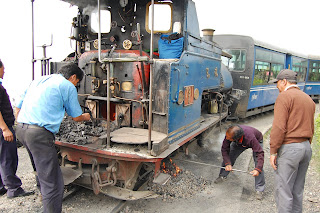Unfortunately, our camera chip picked up a virus from a computer so many of our pictures of Darjeeling were ruined. The city is a magnificent sprawl over a steep ridge, surrounded by the famed tea plantations and a backdrop of Himalayas. The town is composed of beautiful colonial buildings and steep narrow streets perfect for wandering.

We took a two hour joy ride on Darjeeling's toy-train, steaming it's way on two-foot wide tracks alongside cliffs and wide valleys. This renowned narrow-gauge railway, birthed in 1881, is one of the last of its kind in the world.


The rail-line coexisting with a typical street.

By far the tastiest and most enjoyable meals we eat in all of India take place in tiny shops like this one. Places like these are rarely visited by Westerners, and its really wonderful to sit down with locals and learn bits about each other. As we ventured up north, the fare became heavily Tibetan influenced, including Momo's (rice dough stuffed with veggies and steamed) and Chow mien.

Yuksom is the charming and historic little mountain town where we began our trek into the Kanchenjunga Range.

This is by no means a slum, but rather a typical living community that are found all over and around urban cities. Slums, however, are also very prevalent and usually found just a bit further outside cities. Looking into the slums from slow-moving trains is eye-opening and depressing, as they are truly filthy- places you would wish no human to have to bare, yet they're home to millions.
 This river is used for bathing, defecating, leisure swimming, laundry, trash and sometimes body disposal (as we witnessed). Needless to say, sanitation is appalling and a major problem. While India continues to develop at an incredible rate in some sectors, contributing to its role as a world power, there remain some major social, health, and economic issues that we have been moved by and feel will hinder the whole of India's progression in the future. Everyday we witness cruel tones of the caste system.
This river is used for bathing, defecating, leisure swimming, laundry, trash and sometimes body disposal (as we witnessed). Needless to say, sanitation is appalling and a major problem. While India continues to develop at an incredible rate in some sectors, contributing to its role as a world power, there remain some major social, health, and economic issues that we have been moved by and feel will hinder the whole of India's progression in the future. Everyday we witness cruel tones of the caste system.  Weaving through train stations overloads the senses with hawkers of all sorts yelling and vying for your attention. Rickshaws, autorickshaws, and taxis line up in the hundreds.
Weaving through train stations overloads the senses with hawkers of all sorts yelling and vying for your attention. Rickshaws, autorickshaws, and taxis line up in the hundreds.

No comments:
Post a Comment